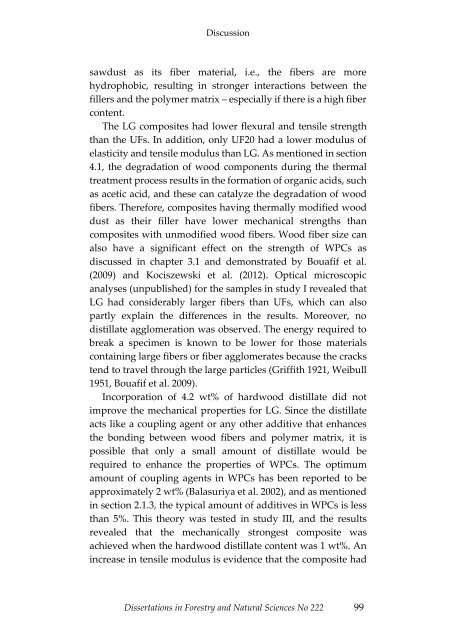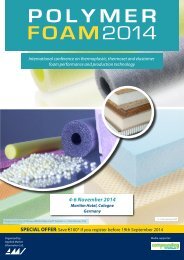Dissertations in Forestry and Natural Sciences
24lYKFN
24lYKFN
You also want an ePaper? Increase the reach of your titles
YUMPU automatically turns print PDFs into web optimized ePapers that Google loves.
Discussion<br />
sawdust as its fiber material, i.e., the fibers are more<br />
hydrophobic, result<strong>in</strong>g <strong>in</strong> stronger <strong>in</strong>teractions between the<br />
fillers <strong>and</strong> the polymer matrix – especially if there is a high fiber<br />
content.<br />
The LG composites had lower flexural <strong>and</strong> tensile strength<br />
than the UFs. In addition, only UF20 had a lower modulus of<br />
elasticity <strong>and</strong> tensile modulus than LG. As mentioned <strong>in</strong> section<br />
4.1, the degradation of wood components dur<strong>in</strong>g the thermal<br />
treatment process results <strong>in</strong> the formation of organic acids, such<br />
as acetic acid, <strong>and</strong> these can catalyze the degradation of wood<br />
fibers. Therefore, composites hav<strong>in</strong>g thermally modified wood<br />
dust as their filler have lower mechanical strengths than<br />
composites with unmodified wood fibers. Wood fiber size can<br />
also have a significant effect on the strength of WPCs as<br />
discussed <strong>in</strong> chapter 3.1 <strong>and</strong> demonstrated by Bouafif et al.<br />
(2009) <strong>and</strong> Kociszewski et al. (2012). Optical microscopic<br />
analyses (unpublished) for the samples <strong>in</strong> study I revealed that<br />
LG had considerably larger fibers than UFs, which can also<br />
partly expla<strong>in</strong> the differences <strong>in</strong> the results. Moreover, no<br />
distillate agglomeration was observed. The energy required to<br />
break a specimen is known to be lower for those materials<br />
conta<strong>in</strong><strong>in</strong>g large fibers or fiber agglomerates because the cracks<br />
tend to travel through the large particles (Griffith 1921, Weibull<br />
1951, Bouafif et al. 2009).<br />
Incorporation of 4.2 wt% of hardwood distillate did not<br />
improve the mechanical properties for LG. S<strong>in</strong>ce the distillate<br />
acts like a coupl<strong>in</strong>g agent or any other additive that enhances<br />
the bond<strong>in</strong>g between wood fibers <strong>and</strong> polymer matrix, it is<br />
possible that only a small amount of distillate would be<br />
required to enhance the properties of WPCs. The optimum<br />
amount of coupl<strong>in</strong>g agents <strong>in</strong> WPCs has been reported to be<br />
approximately 2 wt% (Balasuriya et al. 2002), <strong>and</strong> as mentioned<br />
<strong>in</strong> section 2.1.3, the typical amount of additives <strong>in</strong> WPCs is less<br />
than 5%. This theory was tested <strong>in</strong> study III, <strong>and</strong> the results<br />
revealed that the mechanically strongest composite was<br />
achieved when the hardwood distillate content was 1 wt%. An<br />
<strong>in</strong>crease <strong>in</strong> tensile modulus is evidence that the composite had<br />
<strong>Dissertations</strong> <strong>in</strong> <strong>Forestry</strong> <strong>and</strong> <strong>Natural</strong> <strong>Sciences</strong> No 222 99



